
Lithobates pipiens formerly Rana pipiens, commonly known as the northern leopard frog, is a species of leopard frog from the true frog family, native to parts of Canada and the United States. It is the state amphibian of Minnesota and Vermont.

The Pennsylvania wood cockroach or Pennsylvanian cockroach is a common species of cockroach in eastern and central North America.

The Photurinae are a subfamily of fireflies (Lampyridae). They contain many of the well-known North American species, such as the Pennsylvania firefly, state insect of Pennsylvania. They are among the "flashing" fireflies known as "lightning bugs" in North America, although they are not too distantly related to the flashing fireflies in the Lampyrinae; as the most basal lineages of that subfamily do not produce light at all, the Photurinae's flashing signals seem to be convergent evolution.

Syritta is a genus of hoverflies, family Syrphidae.

Eristalinae are one of the four subfamilies of the fly family Syrphidae, or hoverflies. A well-known species included in this subfamily is the dronefly, Eristalis tenax.

The Tingidae are a family of very small insects in the order Hemiptera that are commonly referred to as lace bugs. This group is distributed worldwide with about 2,000 described species.

Syritta pipiens, sometimes called the thick-legged hoverfly, is one of the most common species in the insect family Syrphidae. This fly originates from Europe and is currently distributed across Eurasia and North America. They are fast and nimble fliers, and their larvae are found in wet, rotting organic matter such as garden compost, manure, and silage. The species is also commonly found in human-created environments such as most farmland, gardens, and urban parks, wherever there are flowers. This species is an important part of its native ecosystem as adult Syritta pipiens flies are critical pollinators for a variety of flowering plants and the species supports parasitism by various parasitic wasp species. Thus, they play an important role in environmental functionality, and can serve as bio-indicators, in which their abundance can reflect the health of the environment. Syritta pipiens looks like many predatory hoverfly species, yet is not predatory.
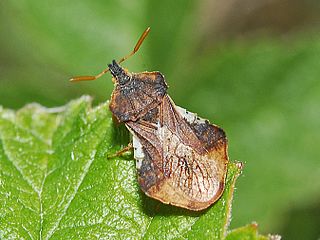
Phymata crassipes is a species of assassin and thread-legged bugs belonging to the family Reduviidae, subfamily Phymatinae.

Phymata is a genus of assassin bugs belonging to the family Reduviidae, subfamily Phymatinae, commonly called jagged ambush bugs. They can be a variety of colors, with their coloring helping them camouflage with the plants they live on. They are predators.

Phymata borica is a species of ambush bug in the family Reduviidae. It is found in North America.

Systena frontalis, the red-headed flea beetle, is a species of flea beetle in the family Chrysomelidae. It is found in North America. It is named for its red colored head that contrasts its black body. Like other flea beetles, it has powerful saltatorial hind legs specialized for jumping. Like all beetles, this insect is holometabolous The larvae are off white in color, 5-10mm in length, have a sclerotized head capsule and a short posterior protrusion.
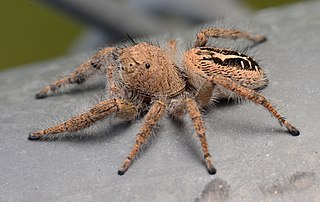
Phidippus texanus is a species of jumping spider in the family Salticidae. It is found in the United States and Mexico.
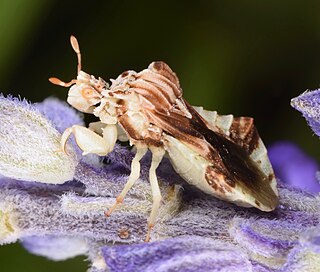
Phymata fasciata is a species of ambush bug in the family Reduviidae. It is found in Central America and North America.
Phymata pacifica is a species of ambush bug in the family Reduviidae. It is found in North America.
Phymata arctostaphylae is a species of ambush bug in the family Reduviidae. It is found in North America.
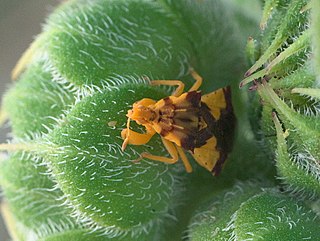
Phymata americana, known as the ambush bug, is a Phymatinae, or ambush bug in the family Reduviidae. It can be found on the flowers of various plants in Central America and North America, where it waits to prey on other insects.
Atheta pennsylvanica is a species of rove beetle in the family Staphylinidae. It is found in North America.

Phymata noualhieri is a species of ambush bug in the family Reduviidae. It is found in Central America and North America.
Agelenopsis pennsylvanica, commonly known as the Pennsylvania funnel-web spider or the Pennsylvania grass spider, is a species of spider in the family Agelenidae. The common name comes from the place that it was described, Pennsylvania, and the funnel shape of its web. Its closest relative is Agelenopsis potteri.
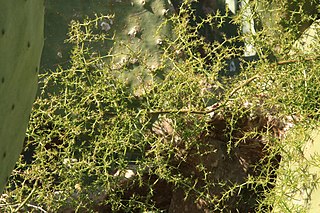
Asparagus aphyllus is a species of plants in the family Asparagaceae. They are climbing plants. Flowers are visited by the Western honey bee, Syritta pipiens, Phthiria, and Halictus.


















